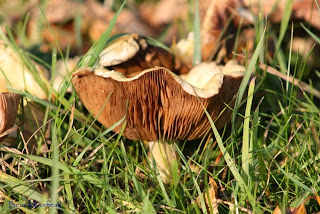24th Oct.
It was a perfect autumn day with clear skies and a warm sun, if a
somewhat cold feel to the air near to the coast. I was with Lee and his friend Zenab, so the
conversation turned to birds in Iraq
for at least part of our journey up to Cresswell. We found a flock of Pink-footed Geese on our journey.
Our initial stop brought us seven Red
Throated Divers eventually making north away from a flock of gulls which
seemed to have found an easy feeding area.
Two Eider Ducks nearby were
easily seen on a flat sea, very different from yesterday when the wind was
up. Waders included numbers of Ringed Plover, Oystercatcher, Turnstone,
Redshank and Curlew. A Sparrowhawk flew from the west over our
heads and flew along the coast line, with markings showing very clearly against
the blue sky and in the sunlight. A male
Stonechat was seen as we drove
towards Cresswell Pond.
Numbers of Tree
Sparrows, Goldfinches and a large flock of overhead Lapwing greeted us as we walked to the hide. The highlight seen from the hide was the
eight Whooper Swans. At least eight Common Snipe rested close to the hide and others flew high above
the pond. I caught sight of a Godwit species overhead, but the Water
Rail which had shown well before our arrival was now lying low. The water was very high and quite clear of
birds, although numbers of Wigeon
and Teal were around the edges of
the pond with one lone Teal directly
in front of the hide. I was beginning to
feel the cold air as we set off for East Chevington.
The North Pool rewarded us with a single Slavonian Grebe, at least seven Pintail,
twenty plus Gadwall, more Wigeon and Teal, numbers of Goldeneye
and a chat with DY. We were noticing
numbers of Red Admiral Butterflies
on the wing today.
We made a quick visit to Druridge Bay
Country Park,
not in any expectation of finding much bird life, but for me just to quickly
check out the route of an RSPB walk I’m co-leading on 4th
January. Anyone fancy a brisk New Year
walk? We’ll have hot drinks and even
mince pies to tempt you perhaps. Anyway,
we didn’t see much here to warm the blood in the way of birds, but we did find
a rather nice pristine fungus which I was told by a helpful passer by is
commonly named Penny Bun Fungus (or was it Halfpenny Bun Fungus?). I’ve looked it up on the internet and what is
called a Penny Bun Fungus there, looks nothing like what I saw. Can anyone advise please?
Penny.Halfpenny Bun Fungus??? Can anyone help?
I don't know this one either.
Nor these. I 'm just to tired to check my very helpful book if I'm honest.
Having made for Druridge Pools we found very little about,
although we did find more Red Admiral
Butterflies and a lone Peacock Butterfly. What I think was a Small Tortoiseshell Butterfly was seen in flight. As we prepared to leave we saw the pair of Stonechat. It’s nice to see that these birds may be
recovering a little after the recent severe winters caused them almost to
disappear from the area.
I can't help feeling I won't be seeing many more butterflies this year.
A hide with a view...only this one at Druridge Pools didn't include many birds today!
We decided to give a second stop at Cresswell Pond a miss,
as the water was so high we weren’t hopeful that there would be anything new
from our previous visit. The north end
of the pond was devoid of life apart from a few gulls and a single Redshank. The road was flooded too.
We stopped at the Queen Elizabeth 11 Park where the only a
single Pochard stood out from
numbers of Tufted Duck, Canada Geese
and Mute Swans. The latter species being very well fed by
passers by. I can think of a few folk
who wouldn’t like the idea of Mute Swans
being fed!!! :-) Clearly Swanbusters have not reached this area
as yet.





No comments:
Post a Comment